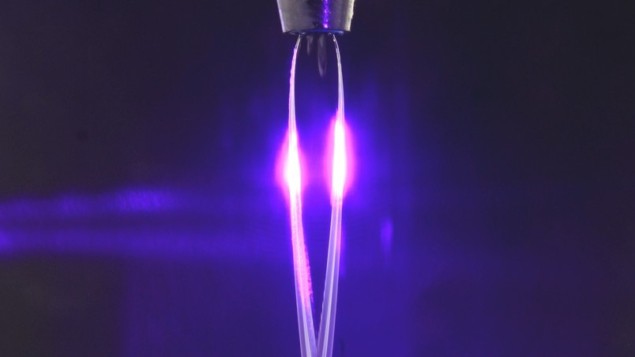
A laser-controlled water-based switch that operates twice as fast as existing semiconductor switches has been developed by a trio of physicists in Germany. Adrian Buchmann, Claudius Hoberg, Fabio Novelli at Ruhr University Bochum used an ultrashort laser pulse to create a temporary metal-like state in a jet of liquid water. This altered the transmission of terahertz pulses over timescales of just tens of femtoseconds.
With the latest semiconductor-based switches approaching fundamental upper limits on how fast they can operate, researchers are on the hunt for faster ways of switching signals. One unexpected place to look for inspiration is the curious behaviour of water under extreme conditions – like those deep within ice-giant planets or created by powerful lasers.
Molecular dynamics simulations suggest water enters a metallic state at pressures of 300 GPa and temperatures of 7000 K. While such conditions do not occur on Earth, it is possible that this state contributes to the magnetic fields of Uranus and Neptune. To study this effect closer to home, recent experiments have used powerful, ultrashort laser pulses to trigger photo-ionization in water-based solutions – creating fleeting, metal-like states.
Liquid jet
In the study, the trio in Bochum fired laser pulses at a water-based solution of sodium iodide. The solution was sprayed from a specialized nozzle, which flattened the liquid jet into a micron-thick sheet. When subjected to an intense optical laser pulse that lasted for 50 fs, electrons from the iodide ions become excited into the conduction band of the liquid water. This “pump” pulse makes the water behave like a metal, at least temporarily.

Water proves to be electrically dead at interfaces
While in this metal-like state, the water’s optical properties are temporarily altered. To detect this change Buchmann, Hoberg and Novelli fired a “probe” pulse of terahertz radiation at the water and measured how much of the probe pulse was transmitted though the water. When the pump and probe pulses overlapped with zero delay, they found that the transmission fell by 20% compared to transmission in the absence of a pump pulse. By increasing the delay between the pump and probe, the team determined that it took just 70 fs for the water to relax from a metal to its normal state.
The terahertz probe pulses were about 1 ps long, which is significantly longer than the pump pulse and the relaxation time of the water. This allowed the team to change the shapes of the transmitted probe pulses, shifting the frequencies in the pulses to higher values. The trio says that this frequency-shifting effect could have useful applications in experiments.
Looking further into the future, the trio hopes that its research could pave the way for a new field of “water electronics”. With switching time of just 70 fs, water is already twice as fast as the best semiconductor switches, which take about 150 fs to change state.
The research is described in APL Photonics.



